
Manga are comics or graphic novels originating from Japan. Most manga conform to a style developed in Japan in the late 19th century, and the form has a long history in earlier Japanese art. The term manga is used in Japan to refer to both comics and cartooning. Outside of Japan, the word is typically used to refer to comics originally published in Japan and published in translation, i.e. a Japanese comic book with English text.
Shōnen manga is an editorial category of Japanese comics targeting an audience of adolescent boys. It is, along with shōjo manga, seinen manga, and josei manga, one of the primary editorial categories of manga. Shōnen manga is traditionally published in dedicated manga magazines that exclusively target the shōnen demographic group.
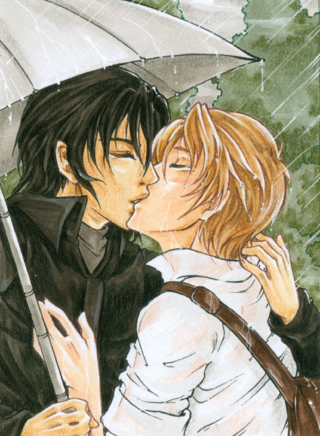
Yaoi, also known as boys' love and its abbreviation BL, is a genre of fictional media originating in Japan that features homoerotic relationships between male characters. It is typically created by women for women and is thus distinct from bara, a genre of homoerotic media marketed to gay men, though yaoi does also attract a male audience and can be produced by male creators. Yaoi spans a wide range of media, including manga, anime, drama CDs, novels, video games, television series, films, and fan works. While "yaoi" is commonly used in the west as an umbrella term for Japanese-influenced media with male-male relationships, "boys' love" and "BL" are the generic terms for this kind of media in Japan and much of Asia.
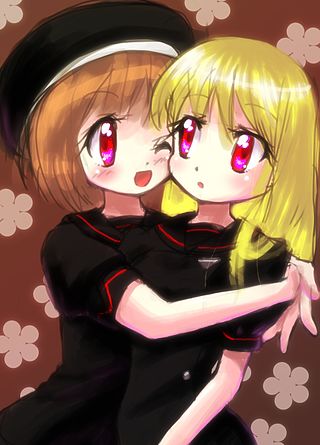
Yuri, also known by the wasei-eigo construction girls' love, is a genre of Japanese media focusing on intimate relationships between female characters. While lesbianism is a commonly associated theme, the genre is also inclusive of works depicting emotional and spiritual relationships between women that are not necessarily romantic or sexual in nature. Yuri is most commonly associated with anime and manga, though the term has also been used to describe video games, light novels, and literature.
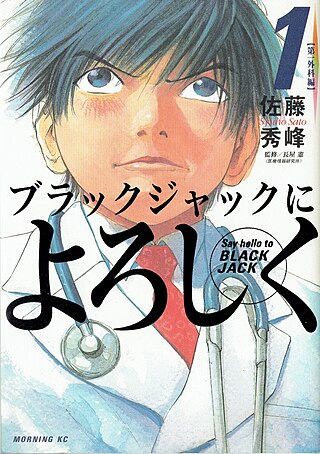
Seinen manga (青年漫画) is an editorial category of Japanese comics marketed toward young adult men. In Japanese, the word seinen literally means "youth", but the term "seinen manga" is also used to describe the target audience of magazines like Weekly Manga Times and Weekly Manga Goraku which write on topics of interest to male university students and working men. Seinen manga are distinguished from shōnen manga which are for young boys, and seijin-muke manga 成人向け漫画 which are about sex. Some seinen manga like xxxHolic share similarities with shōnen manga. Seinen manga can focus on action, politics, science fiction, fantasy, relationships, sports, or comedy. The female equivalent to seinen manga is josei manga.
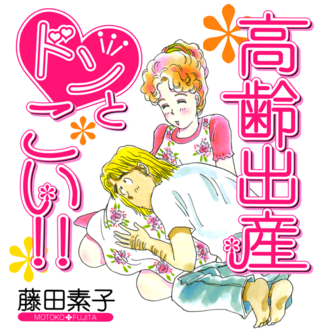
Josei manga, also known as ladies' comics (レディースコミック) and its abbreviation redikomi , is an editorial category of Japanese comics that emerged in the 1980s. In a strict sense, josei refers to manga marketed to an audience of adult women, contrasting shōjo manga, which is marketed to an audience of girls and young adult women. In practice, the distinction between shōjo and josei is often tenuous; while the two were initially divergent categories, many manga works exhibit narrative and stylistic traits associated with both shōjo and josei manga. This distinction is further complicated by a third manga editorial category, young ladies (ヤングレディース), which emerged in the late 1980s as an intermediate category between shōjo and josei.

Weekly Shōnen Jump is a weekly shōnen manga anthology published in Japan by Shueisha under the Jump line of magazines. The manga series within the magazine consist of many action scenes and a fair amount of comedy. Chapters of the series that run in Weekly Shōnen Jump are collected and published in tankōbon volumes under the Jump Comics imprint every two to three months. It is one of the longest-running manga magazines, with the first issue being released with a cover date of August 1, 1968.

Shogakukan Inc. is a Japanese publisher of dictionaries, literature, comics (manga), non-fiction, DVDs, and other media in Japan.
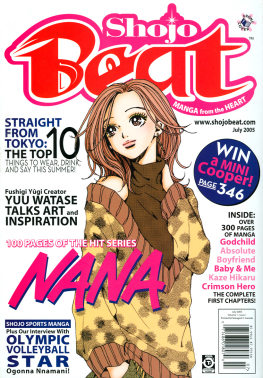
Shojo Beat is a shōjo manga magazine formerly published in North America by Viz Media. Launched in June 2005 as a sister magazine for Shonen Jump, it featured serialized chapters from six manga series, as well as articles on Japanese culture, manga, anime, fashion and beauty. After its initial launch, Shojo Beat underwent two redesigns, becoming the first English anthology to use the cyan and magenta ink tones common to Japanese manga anthologies. Viz launched a related imprint of the same name for female-oriented manga, light novels and anime.

Hakusensha, Inc. is a Japanese publishing company. It is headquartered in Chiyoda, Tokyo.
Digital Manga is a California-based publishing company that licenses and releases Japanese manga, anime, and related merchandise in the English language.
Manga, or comics, have appeared in translation in many different languages in different countries. France represents about 40% of the European comic market and in 2011 manga represented 40% of the comics being published in the country. In 2007, 70% of the comics sold in Germany were manga. In the United States, manga comprises a small industry, especially when compared to the inroads that Japanese animation or Japanese video games have made in the USA. One example of a manga publisher in the United States, VIZ Media, functions as the American affiliate of the Japanese publishers Shogakukan and Shueisha. Though the United Kingdom has fewer manga publishers than the U.S., most manga sold in the United Kingdom are published by U.S. publishing companies like Viz media and Kodansha Comics which are in turn owned by their Japanese counterparts. Alongside the United Kingdom, the U.S. manga publishers also sell their English translated manga in other English speaking nations like Canada, Australia and New Zealand with manga being quite popular in Australia compared to other English speaking countries.

Walkin' Butterfly is a josei manga by Chihiro Tamaki. It was serialized by Kodansha in the manga magazine Vanilla until the magazine ceased publication in 2003, then by Kadokawa X Media by mobile phone until the series concluded in 2007. The series was collected in four bound volumes by Ohzora Publishing. The manga is licensed in North America by Aurora Publishing. The series was adapted as a live-action drama broadcast on TV Tokyo from 11 July to 26 September 2008. It depicts a young woman's struggles to overcome her insecurity about her height by becoming a model.

ASCII Media Works, formerly ASCII Media Works, Inc., is a Japanese publisher and brand company of Kadokawa Future Publishing headquartered in Nishi-Shinjuku, Shinjuku, Tokyo, Japan. It originally formed on April 1, 2008, as a result of a merger between ASCII Corporation and MediaWorks where MediaWorks legally absorbed ASCII. Despite this, the former president and CEO of ASCII, Kiyoshi Takano, became the first president and CEO of ASCII Media Works. It became an internal division of Kadokawa Corporation on October 1, 2013.

Shonen Jump, officially stylized SHONEN JUMP and abbreviated SJ, was a shōnen manga anthology published in North America by Viz Media. It debuted in November 2002 with the first issue having a January 2003 cover date. Based on Shueisha's popular Japanese magazine Weekly Shōnen Jump, Shonen Jump was retooled for English readers and the American audience, including changing it from a weekly publication to a monthly one. It featured serialized chapters from different manga series and articles on Japanese language and culture, as well as manga, anime, video games, and figurines. The premiere issue of Shonen Jump also introduced the first official English translations of One Piece, Sand Land, Yu-Gi-Oh!, YuYu Hakusho, and Naruto.
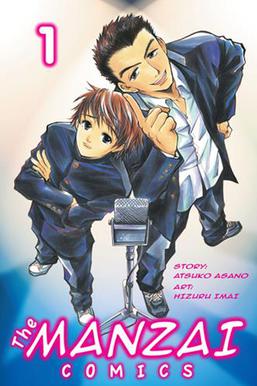
The Manzai Comics is a manga series written by Atsuko Asano and illustrated by Hizuru Imai. In Japan it is published by Jive. In the United States it is published by Aurora Publishing.
Ohzora Publishing, Inc. (宙出版), also known as Ohzora Shuppan is a josei manga publisher in Japan, founded in 1990. Headquartered in Tokyo, Japan, it publishes Japanese manga, manga magazines and comic anthologies. The company is headed by Nobuo Kitawaki (北脇信夫). Kitawaki also ran affiliated American company Aurora Publishing, established in 2006 before it closed in 2010. Aurora Publishing was the U.S. subsidiary of Ohzora.
Sounds of Love is a Japanese manga written and illustrated by Rin Tanaka. It was published by Ohzora Publishing in Japan in December 2007, and released by Aurora Publishing in English in November 2008.

Shueisha Inc. is a Japanese publishing company headquartered in Chiyoda, Tokyo, Japan. Shueisha is the largest publishing company in Japan. It was established in 1925 as the entertainment-related publishing division of Japanese publisher Shogakukan. The following year, Shueisha became a separate, independent company.

Shōjo manga is an editorial category of Japanese comics targeting an audience of adolescent females and young adult women. It is, along with shōnen manga, seinen manga, and josei manga, one of the primary editorial categories of manga. Shōjo manga is traditionally published in dedicated manga magazines, which often specialize in a particular readership age range or narrative genre.















